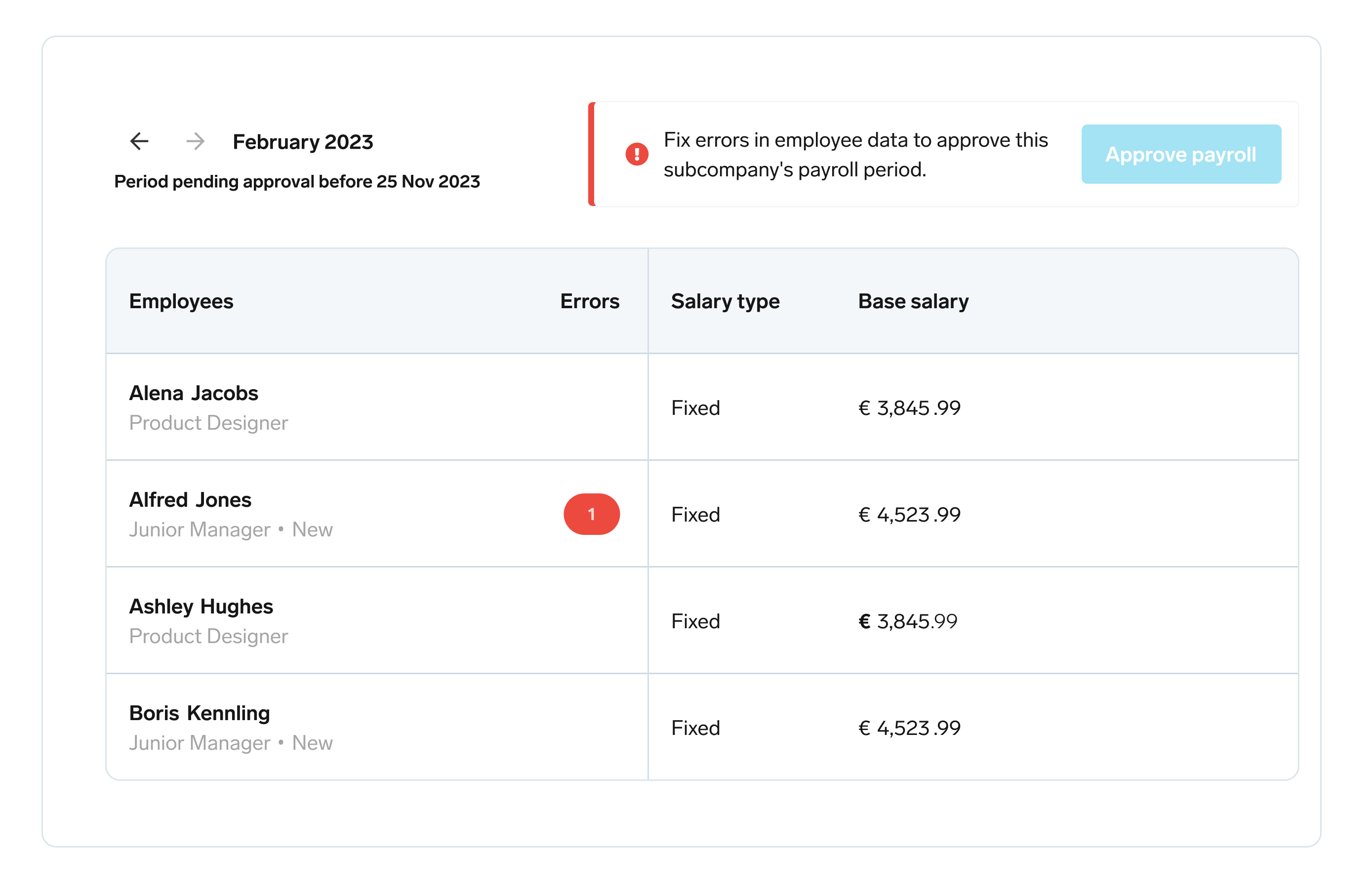
Start simplifying your payroll management
Learn how to streamline your payroll process to save time and ensure accuracy.
Read our guideOccupational Maternity Pay (OMP) Explained

When an employee gets pregnant in the UK, they’re entitled to certain benefits, including time off for antenatal care, 52 weeks’ maternity leave, and — yes — maternity pay, too.
All employers have to pay Statutory Maternity Pay, as long as the employee meets certain criteria. But what about Occupational Maternity Pay? Read on for our full guide to Occupational Maternity Pay for employers.
Start tracking absences across your organisation with Personio today.
What is Occupational Maternity Pay?
Occupational Maternity Pay (OMP) is an optional extra payment that you can make to your employees when they are on maternity leave. It’s sometimes called contractual maternity pay or enhanced maternity pay, and allows you to pay your employees more than just the legally mandated minimum when they take time off to have a baby.
Unlike Statutory Maternity Pay, which all employers have to pay, OMP is completely optional. However, OMP can be a valuable benefit for employees, which can increase staff loyalty and even give your employer brand a boost.
The Differences Between Statutory Maternity Pay (SMP) and OMP
Occupational Maternity Pay is not the same as Statutory Maternity Pay, which is an obligatory maternity allowance for most employees. To clear up any confusion, here are some of the differences between SMP and OMP.
SMP is a legal requirement: SMP is mandatory for all employees as long as they meet certain requirements in terms of income and length of service. OMP, on the other hand, is an optional payment that employers can choose to offer.
SMP is paid at a set rate mandated by the government: The UK government sets the rate at which SMP must be paid. OMP can be paid at any rate you choose.
SMP is paid for a set period: SMP is paid for a maximum of 39 weeks, even if the employee’s maternity leave is longer. If you choose to offer OMP, you could extend this to the full length of your employee’s maternity leave.
SMP doesn’t have to be paid back: If you offer OMP, you can add a condition that employees have to pay it back if they don’t return to work after childbirth.
OMP can have other conditions: You can also add other conditions to OMP, such as requiring employees to have worked for you for a full year, instead of the 26 weeks required for SMP.
You can pay OMP even if employees don’t qualify for SMP: You could choose to pay an employee OMP even if they don’t qualify for SMP because they haven’t yet worked for you for 26 weeks, for example.
Statutory Maternity Pay Entitlement
As an employer, you’re required to pay your employees Statutory Maternity Pay, as long as they:
Give you the correct notice and proof that they are pregnant
Earn on average at least £123 per week
Have been in continuous employment with you for at least 26 weeks prior to the 15th week before their due date
If an employee meets these conditions, then you’re required to pay them:
90% of their average weekly earnings before tax for the first six weeks
90% of their average weekly earnings, or £156.66, whichever is lower, for the next 33 weeks
Occupational Maternity Pay Entitlement
It’s up to you to decide what conditions to attach to any additional maternity benefits that you offer to your employees, including OMP.
Any conditions should be clearly stated in each employee’s employment contract so that there’s no room for confusion or disputes. You could also put this information in your employee handbook so that people can easily access it.
Here are some examples of conditions you could set for OMP eligibility:
Time at your company, e.g. they have to have worked for you for one or two years to benefit from OMP
Contingency on returning to work, i.e. they have to repay all or part of the OMP they received if they choose not to return after their baby is born
Can Employees Get Both SMP and OMP at the Same Time?
When you choose to pay OMP to your employees, you still have to pay SMP, so your employees will get both payments at the same time.
At a Glance: Easily Manage Absences Across Your Org

Make absence planning and tracking a pleasure, and not a pain, with Personio.
Track absences with PersonioHow Does Occupational Maternity Pay Work?
Still have questions? Here are the answers to some FAQs on how OMP works.
How Much Is Occupational Maternity Pay?
There’s no set figure for OMP, since it’s an optional payment. If you choose to pay it, it’s important to take the time to think about the rate you’ll pay for each stage of the employee’s maternity leave. Remember that you’ll also have to pay SMP, so any Occupational Maternity Pay you choose to pay will be in addition to this.
How Long Does OMP Last?
Since Occupational Maternity Pay is optional, there’s no set period where you have to pay it. Employees are entitled to Statutory Maternity Pay for a maximum of 39 weeks, though the maximum maternity leave an employee can take in the UK is 52 weeks. You could choose to use OMP to extend your employees’ maternity pay for the entire length of their leave.
Example of an OMP Plan
You can choose to organise OMP any way you like, though you should remember that you’ll also be required to pay SMP for the first 39 weeks of your employees’ maternity leave. To help you, here’s an example of an OMP plan.
Imagine you have an employee who normally earns £500 per week. When they take maternity leave, you could choose to pay them according to the following structure:
Weeks | SMP | OMP | Percentage of Normal Salary |
|---|---|---|---|
1-6 | $450/week | £50/week | 100% |
7-12 | £156.66/week | £343.34/week | 100% |
13-20 | 156.66/week | £93.34/week | 50% |
21-39 | 156.66/week | No OMP | ≈ 30% |
40-52 | No SMP | No OMP | 0% |
Remember that there are many different ways to structure your OMP plan, and this is just one example.
Do Employees Have to Pay OMP Back?
You can choose to include a clause in your employment contracts stating that employees will have to pay back OMP if they don’t return to work when their maternity leave is over.
If you choose this route, you should be specific about how much of the Occupational Maternity Pay they received your employees would have to pay back, and the minimum period they have to return to work for in order to keep it. For example, your contract could state that they have to pay back 50% of the OMP they received if they don’t return to work for a minimum of three months after their leave ends.
Alternatively, you could frame this more positively by offering part of the OMP you allocate to employees in the form of a return-to-work bonus that they’ll receive when they return.
Either way, it’s important to be transparent with your employees about the conditions attached to their OMP.
Should You Implement OMP as an Employer?
There’s no easy yes-or-no answer to whether you should provide Occupational Maternity Pay as an employer — only you can decide.
The main downside of offering OMP is the added cost it represents, which means it might not be an option for some companies. However, there are some advantages to be had from offering OMP as well:
Increased chances of staff returning to work: If you offer OMP, your employees are more likely to want to return to work for you after their maternity leave is over. Choosing to give OMP voluntarily shows that you’re an employer that values family and will allow them to have the work-life balance they might need as new parents.
Improvements to retention generally: Showing your employees that you value them outside of just their work output is a great way to boost retention, even if they’re not having babies right now. Plus, people who plan on starting a family in the future are more likely to stay with your company if they know they’ll be supported when the time comes.
Increased staff loyalty: Offering benefits like OMP to your employees can help them to feel connected to your organisation and loyal to you as an employer in return.
Boosts your employer brand: These days, people are not just looking for the jobs that pay the most. Extra benefits like OMP can go a long way in helping you land the top talent.
Final Verdict: Occupational Maternity Leave
Your employees going on maternity leave is a great time to show them that you value and appreciate them by offering OMP if it’s an option for your company. If you want more information on how parental leave works in the UK, including shared parental leave, adoption leave, and employees’ rights while on leave, read our full maternity leave guide.
Disclaimer
We would like to inform you that the contents of our website (including any legal contributions) are for non-binding informational purposes only and does not in any way constitute legal advice. The content of this information cannot and is not intended to replace individual and binding legal advice from e.g. a lawyer that addresses your specific situation. In this respect, all information provided is without guarantee of correctness, completeness and up-to-dateness.